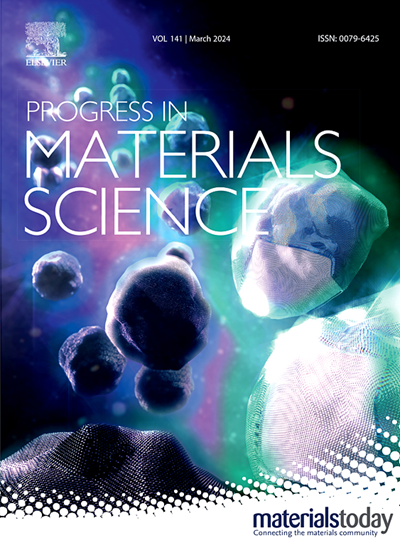Recent progress in metal chalcogenide-MXene and MOF-derived composites for supercapacitors: synthesis, challenges, and future solutions
IF 40
1区 材料科学
Q1 MATERIALS SCIENCE, MULTIDISCIPLINARY
引用次数: 0
Abstract
Metal chalcogenide-based electrode materials have gained a substantial attention as high-performance electrode alternative for supercapacitors owing to their tunable redox characteristics, high electrical conductivity, and enrich electrochemical activity. Recent advancements in composite materials, especially the integration of metal chalcogenides with MXenes and metal organic framework (MOF)-derived structures have unlocked innovative paths for surpassing inherent challenges such as poor cycling stability, accumulation, and low surface area. This review article delivers an inclusive summary of the synthesis strategies employed for evolving these hybrid composites electrodes, including hydrothermal, chemical bath deposition, and in situ growth techniques. The synergistic integration of MXenes, recognized for their excellent electrical conductivity and mechanical strength, with metal chalcogenides improves electron transport and structural stability. Correspondingly, the MOF-derived porous frameworks begin with a high surface area and controlled structure, further enhancing capacitance and ion diffusion. Despite these developments some key challenges remain, such as structural degradation, complex synthesis processes, and meager long-term electrochemical stability. This review also focusses on emerging approaches to resolve these challenges, such as defect engineering, heteroatom doping, and surface functionalization. Conclusively, the future perspectives are anticipated for scalable fabrication, flexible device integration, and performance optimization, pointing toward the next generation of high-energy–density supercapacitor systems.
金属硫族化合物- mxene和mof衍生超级电容器复合材料的最新进展:合成、挑战和未来解决方案
金属硫族化合物电极材料因其可调的氧化还原特性、高导电性和丰富的电化学活性而成为超级电容器的高性能电极替代品。复合材料的最新进展,特别是金属硫族化合物与MXenes和金属有机框架(MOF)衍生结构的集成,为克服循环稳定性差、积累和低表面积等固有挑战开辟了创新途径。这篇综述文章提供了一个全面的总结,用于发展这些杂化复合材料电极的合成策略,包括水热、化学浴沉积和原位生长技术。MXenes具有优异的导电性和机械强度,与金属硫族化合物协同集成,提高了电子传递和结构稳定性。相应地,mof衍生的多孔框架具有高表面积和可控结构,进一步增强了电容和离子扩散。尽管取得了这些进展,但仍存在一些关键挑战,如结构降解、复杂的合成过程和长期电化学稳定性差。本文还重点介绍了解决这些挑战的新方法,如缺陷工程、杂原子掺杂和表面功能化。最后,展望了可扩展制造、灵活器件集成和性能优化的未来前景,并指出了下一代高能量密度超级电容器系统。
本文章由计算机程序翻译,如有差异,请以英文原文为准。
求助全文
约1分钟内获得全文
求助全文
来源期刊

Progress in Materials Science
工程技术-材料科学:综合
CiteScore
59.60
自引率
0.80%
发文量
101
审稿时长
11.4 months
期刊介绍:
Progress in Materials Science is a journal that publishes authoritative and critical reviews of recent advances in the science of materials. The focus of the journal is on the fundamental aspects of materials science, particularly those concerning microstructure and nanostructure and their relationship to properties. Emphasis is also placed on the thermodynamics, kinetics, mechanisms, and modeling of processes within materials, as well as the understanding of material properties in engineering and other applications.
The journal welcomes reviews from authors who are active leaders in the field of materials science and have a strong scientific track record. Materials of interest include metallic, ceramic, polymeric, biological, medical, and composite materials in all forms.
Manuscripts submitted to Progress in Materials Science are generally longer than those found in other research journals. While the focus is on invited reviews, interested authors may submit a proposal for consideration. Non-invited manuscripts are required to be preceded by the submission of a proposal. Authors publishing in Progress in Materials Science have the option to publish their research via subscription or open access. Open access publication requires the author or research funder to meet a publication fee (APC).
Abstracting and indexing services for Progress in Materials Science include Current Contents, Science Citation Index Expanded, Materials Science Citation Index, Chemical Abstracts, Engineering Index, INSPEC, and Scopus.
 求助内容:
求助内容: 应助结果提醒方式:
应助结果提醒方式:


